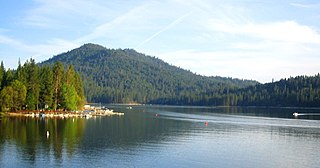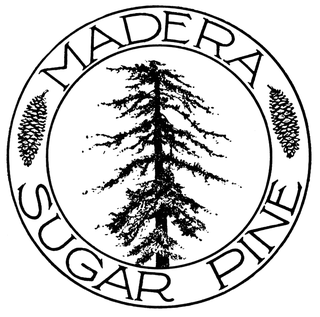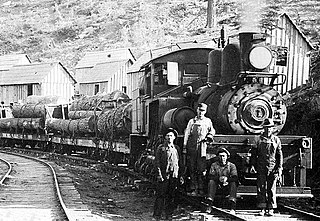
A log flume is a watertight flume constructed to transport lumber and logs down mountainous terrain using flowing water. Flumes replaced horse- or oxen-drawn carriages on dangerous mountain trails in the late 19th century. Logging operations preferred flumes whenever a reliable source of water was available. Flumes were cheaper to build and operate than logging railroads. They could span long distances across chasms with more lightweight trestles.

Nelder Grove, located in the western Sierra Nevada within the Sierra National Forest in Madera County, California, is a Giant sequoia grove that was formerly known as Fresno Grove. The grove is a 1,540-acre (6.2 km2) tract containing 54 mature Giant Sequoia trees, the largest concentration of giant sequoias in the Sierra National Forest. The grove also contains several historical points of interest, including pioneer cabins and giant sequoia stumps left by 19th century loggers.

Bass Lake is a popular recreational area located in Madera County, California, within the Sierra National Forest, approximately 14 mi (23 km) miles south of the entrance to Yosemite National Park. Formed by the Crane Valley Dam on Willow Creek, a tributary to the San Joaquin River, the lake is approximately four miles (6.4 km) long and one-half mile (0.80 km) wide. The 145 ft (44 m) concrete gravity dam was completed in 1910 by Pacific Gas and Electric. Releases from the dam drive a hydro-electric powerplant. The lake supports a diverse ecosystem, including species such as black bears, mule deer, bald eagles, and Great blue herons, along with a variety of fish species.
North Fork is a unincorporated community in Madera County, California, United States. As of the 2020 United States census it had a population of 3,250. For statistical purposes, the United States Census Bureau has defined North Fork as a census-designated place (CDP). North Fork is part of the Madera Metropolitan Statistical Area and is home to the tribal headquarters of the Northfork Rancheria of Mono Indians of California.

The San Joaquin Valley Railroad is one of several short line railroad companies and is part of the Western Region Division of Genesee & Wyoming Inc. It operates over about 371 miles (597 km) of owned or leased track primarily on several lines in California's Central Valley/San Joaquin Valley around Fresno and Bakersfield. The SJVR has trackage rights over Union Pacific between Fresno, Goshen, Famoso, Bakersfield and Algoso. The SJVR also operated for the Tulare Valley Railroad (TVRR) from Calwa to Corcoran and Famoso.

The Yosemite Mountain Sugar Pine Railroad (YMSPRR) is a historic 3 ft narrow gauge railroad with two operating steam train locomotives located near Fish Camp, California, in the Sierra National Forest near the southern entrance to Yosemite National Park. Rudy Stauffer organized the YMSPRR in 1961, utilizing historic railroad track, rolling stock and locomotives to construct a tourist line along the historic route of the Madera Sugar Pine Lumber Company.

The Minarets and Western Railway was a Class II common carrier that operated in Fresno County, California, from 1921 to 1933. The railway was owned by the Sugar Pine Lumber Company and was built the same year the lumber company was incorporated so that it could haul timber from the forest near Minarets to its sawmill at Pinedale. The southern portion of the line was operated with joint trackage rights with Southern Pacific.

A forest railway, forest tram, timber line, logging railway or logging railroad is a mode of railway transport which is used for forestry tasks, primarily the transportation of felled logs to sawmills or railway stations.
Central Camp is an unincorporated community in Madera County, California. It is located 3 miles (4.8 km) west of Shuteye Peak, at an elevation of 5417 feet from the sea-level.

A log pond is a small natural lake or reservoir used for storage of wooden logs in readiness for milling at a sawmill. Although some mill ponds served this purpose for water-powered sawmills, steam-powered sawmills used log ponds for transportation of logs near the mill; and did not require the elevation drop of watermill reservoirs.

The Hume-Bennett Lumber Company was a logging operation in the Sequoia National Forest in the late 19th and early 20th centuries. The company and its predecessors were known for building the world's longest log flume and the first multiple-arch hydroelectric dam. However, the company also engaged in destructive clearcutting logging practices, cutting down 8,000 giant sequoias in Converse Basin in a decade-long event that has been described as "the greatest orgy of destructive lumbering in the history of the world."
The Michigan-California Lumber Company was an early 20th-century Ponderosa and Sugar pine logging operation in the Sierra Nevada. It is best remembered for the Shay locomotives used to move logs to the sawmill.

Arthur H. Fleming was a successful Canadian-American lumber operator in the western United States of America around the turn of the 20th century and is best known as a philanthropist who, with his daughter, gave more than $5,000,000 to the California Institute of Technology (Caltech). Fleming House at Caltech is named in his honor. Fleming also funded the construction of a World War I memorial in Compiègne to house the railroad car in which the 1918 Armstice with Germany was signed. The railcar was later seized by Nazi Germany in 1940.

Shuteye Peak is a mountain located in the Sierra National Forest in Madera County, California on the highest point of Chiquito Ridge. It is home to the first permanent fire lookout built in the Sierra Nevada.

The Madera Sugar Pine Company was a lumber company that operated in the Sierra Nevada region of California during the late 19th and early 20th centuries. It was known for its use of innovative technologies, such as the first log flume and logging railroad in the southern Sierra, and the adoption of the Steam Donkey engine in commercial logging. The company had a significant impact on the region, leading to the founding of several towns, including Madera, Fish Camp, and Sugar Pine, as well as the growth of Fresno Flats and the formation of Madera County. In addition, the company contributed to the agriculture in California in California through its production of wooden shipping boxes and was involved in a U.S. Supreme Court case related to employer obligations.

The Sugar Pine Lumber Company was an early 20th century logging operation and railroad in the Sierra Nevada. Unable to secure water rights to build a log flume, the company operated the “crookedest railroad ever built." They later developed the Minarets-type locomotive, the largest and most powerful saddle tank locomotive ever made. The company was also a pioneer in the electrification of logging where newly plentiful hydroelectric power replaced the widespread use of steam engines.

The Yosemite Lumber Company was an early 20th century Sugar Pine and White Pine logging operation in the Sierra Nevada. The company built the steepest logging incline ever, a 3,100 feet (940 m) route that tied the high-country timber tracts in Yosemite National Park to the low-lying Yosemite Valley Railroad running alongside the Merced River. From there, the logs went by rail to the company’s sawmill at Merced Falls, about fifty-four miles west of El Portal.
The Fresno Flume and Irrigation Company was established in 1891 as a logging and water transportation company in California. A 45-mile cedar flume was built to transport lumber from Shaver Lake to the finishing mill in Clovis. The company changed its name to the Fresno Flume and Lumber Company in 1908, and over the course of its 21-year lifespan, cut an average of 25 million board feet of lumber each year. However, in 1912, the company was sold and ceased all operations after a storm destroyed 2 miles (3.2 km) of the flume. In 1919, Southern California Edison Company bought most of the Shaver property for the Big Creek Hydroelectric Project.
The following is a timeline of the history of the Sierra National Forest in Central California, United States.















